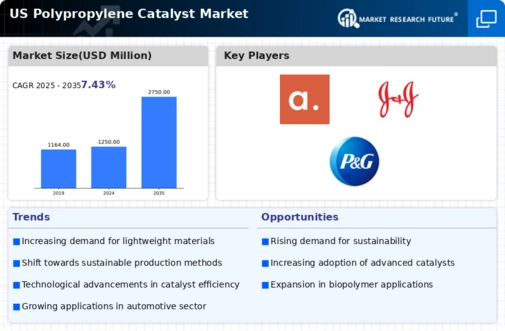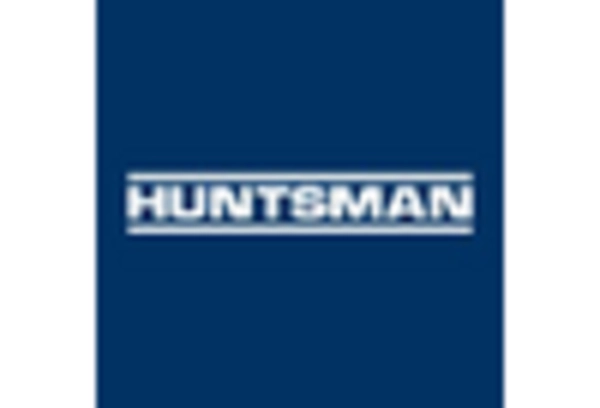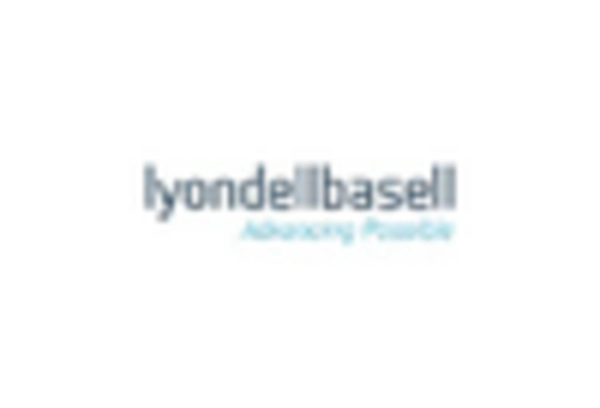Growth of the Automotive Sector
The automotive sector's expansion is a crucial driver for the polypropylene catalyst market. As the industry increasingly adopts lightweight materials to enhance fuel efficiency and reduce emissions, polypropylene has emerged as a preferred choice due to its favorable properties. The US automotive market is projected to witness a compound annual growth rate (CAGR) of approximately 5% over the next few years, further boosting the demand for polypropylene components. This growth is likely to lead to an increased requirement for polypropylene catalysts, as manufacturers seek to optimize production processes and improve the performance of automotive parts. Consequently, the growth of the automotive sector is expected to have a substantial impact on the polypropylene catalyst market, driving innovation and investment in catalyst technologies.
Rising Demand for Polypropylene Products
The polypropylene catalyst market is experiencing a surge in demand driven by the increasing consumption of polypropylene in various applications, including packaging, automotive, and textiles. The packaging sector, in particular, is projected to account for approximately 40% of the total polypropylene consumption in the US. This growth is attributed to the material's lightweight, durability, and recyclability, which align with consumer preferences for sustainable products. As manufacturers seek to enhance production efficiency and product quality, the demand for advanced catalysts is likely to rise, thereby propelling the polypropylene catalyst market. Furthermore, the automotive industry's shift towards lightweight materials to improve fuel efficiency is expected to further stimulate the market, as polypropylene is favored for its favorable properties. Thus, the rising demand for polypropylene products is a key driver influencing the polypropylene catalyst market.
Regulatory Support for Sustainable Practices
The polypropylene catalyst market is positively influenced by regulatory frameworks that promote sustainable practices within the petrochemical industry. In the US, various federal and state regulations encourage the adoption of environmentally friendly production methods and the use of recyclable materials. For instance, initiatives aimed at reducing plastic waste and promoting circular economy principles are gaining traction. These regulations often incentivize manufacturers to invest in advanced catalysts that enhance the efficiency of polypropylene production while minimizing environmental impact. As a result, the polypropylene catalyst market is likely to benefit from increased investments in research and development, leading to the creation of innovative catalysts that meet regulatory standards. This regulatory support not only fosters a more sustainable industry but also drives the demand for high-performance catalysts in the polypropylene catalyst market.
Technological Innovations in Catalyst Development
Technological advancements in catalyst development are significantly shaping the polypropylene catalyst market. Innovations such as the introduction of metallocene catalysts have revolutionized the production of polypropylene, allowing for greater control over polymer properties and enhancing product performance. These advanced catalysts enable manufacturers to produce polypropylene with tailored characteristics, catering to specific market needs. The US market has seen a notable increase in the adoption of such technologies, with estimates suggesting that the use of advanced catalysts could improve production efficiency by up to 30%. As manufacturers strive to remain competitive, the continuous evolution of catalyst technology is likely to drive growth in the polypropylene catalyst market, fostering the development of high-quality polypropylene products that meet diverse consumer demands.
Increasing Focus on Recycling and Circular Economy
The polypropylene catalyst market is being driven by a growing emphasis on recycling and the principles of a circular economy. As consumers and manufacturers alike become more aware of environmental issues, the demand for recycled polypropylene is on the rise. In the US, the recycling rate for polypropylene is estimated to be around 10%, but initiatives aimed at increasing this figure are gaining momentum. The development of catalysts that facilitate the recycling of polypropylene is becoming increasingly important, as they can enhance the efficiency of the recycling process and improve the quality of recycled materials. This focus on recycling not only supports sustainability goals but also creates new opportunities for growth within the polypropylene catalyst market. As the industry adapts to these changing dynamics, the demand for innovative catalysts that support recycling efforts is likely to increase.

















Leave a Comment